7 Direct Response Marketing Examples to Instantly Drive Engagement & Sales
Many people ask what the difference is between brand marketing and direct response marketing.
And the reason for that is when most people think of advertising, they think of massive campaigns by brands like Nike, Microsoft, or Starbucks. Those campaigns are very creative, emotional, and larger than life. Most of all, those brands pull customers in and leave a lasting impression.
If that’s your idea of marketing, as a small business, it can be a bit overwhelming. Especially learning which way to market will be most effective.
So, instead of trying to take on the big brands, you need a different approach. You need to create marketing that drives action today.
Which brings us to direct response marketing.
Direct response marketing is all about making things happen now. It packages the value proposition and call-to-action all in one to take a prospect from consideration to decision faster.
In this article, we will cover all there is to know about direct response marketing, including:
- Part 1: What is direct response marketing?
- Part 2: How to run a successful direct response marketing campaign
- Part 3: 7 direct response marketing examples
- Part 4: The benefits of direct response marketing
What is Direct Response Marketing?
Direct response marketing is designed to elicit an instant response by encouraging prospects to take a specific action.
Direct response advertisements must trigger immediate action from prospects since the goal is to generate leads quickly. In contrast to traditional marketing, which aims to raise brand awareness and promote brand image long term, direct response marketing shows immediate ROI.
Marketers can leverage direct response on any number of channels, including TV, print, radio, email, digital, and social media.
The purpose of direct response marketing is to send customers targeted messages that drive a specific action – buy a product, read your marketing content, subscribe to a newsletter, refer-a-friend, or any relevant business goal.
How to run a successful direct response campaign
There are a handful of different components that make up a successful direct response marketing campaign:
A specific offer
Direct response marketing is aimed at targeted prospects and their specific problem or interest.
A direct response marketing campaign only works if you make a specific offer. You’re not asking people to buy just one of your products. Instead, you’re asking them to buy a specific product.
Additionally, it’s very common to add a discount or other promotion to sweeten the deal and encourage conversions. Without a tempting offer, a direct marketing campaign stands little to no chance for success.
Other examples to increase conversions in your direct response campaigns include time restrictions, giveaways, and information highly sought out by your target audience. The more you refine your offer, the lower your CPA (cost per acquisition) will be.
Personalization and targeting
While it may be tempting to target a super-large audience, direct response marketing works best when you have a specific buyer persona in mind. Take this top Facebook ad hack for example, where you can boost CTR (click-through-rates) significantly by targeting unrelated interests: “Life took me to England but I’ll always be an Arizona girl.”

Look at the comments, they’re comical. People can’t even believe they were served an ad so specific to their background.
But this is nothing sinister. It’s actually been coined the term, “Inverted Unicorn Facebook Ad Targeting Method.”
If you think about it, you know that you can target women, and you know that you can target people who live in the UK, right?
Then, you may also know that you can target behaviors, such as recently moved.
Another great example of a highly-targeted ad comes from mattress companies. In the early days of Facebook ads, one mattress company realized that you could target recently divorced adults. If someone needs to move out of the house, chances are they’ll need a new mattress sleep on, right?
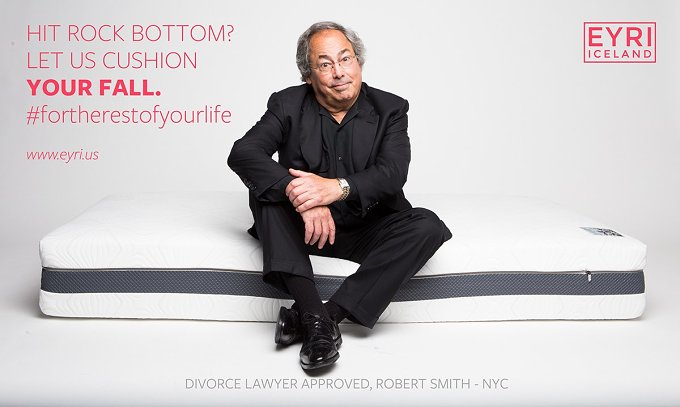
So, if your product and offer are custom-tailored to a persona, you’ll get more interest from the audience and generate more sales. Simple as that.
This doesn’t mean that you have to neglect other buyer personas. It simply means that every direct response marketing campaign you run should focus on a specific buyer persona.
However, you can also take more detailed information from your buyer personas into account. These details could include income, gender, profession, geographical location, and more.
A clear CTA (call-to-action)
Having a clear CTA is of paramount importance to most marketing campaigns. And a direct response ad should always demand an immediate response with a clear call-to-action that compels the prospect to take action now.
That’s why you need a dedicated lead generation tool for each campaign.
When a prospect responds via a lead capture form, it’s important to collect enough contact information to continue nurturing them through your sales funnel. But, to reduce friction, only ask for what’s appropriate at that stage of the funnel.
A good CTA should include the following:
- A strong command verb to start your CTA, such as “shop,” “subscribe,” or “find out how…”
- Words that provoke emotion or enthusiasm, such as “plan your dream vacation today!”
- Take advantage of FOMO – “fear of missing out”
- Numbers whenever possible, such as “25% off,” or “Free 1-day shipping.”
Creating a sense of urgency
Without a deadline or expiration date, your offer becomes far less tempting.
Naturally, consumers will assume that they can return and take advantage of the offer at any time. Since they lead busy lives, those consumers will likely forget altogether. Which isn’t good for business.
Make it clear that your offer extends only for a limited time and that failing to respond immediately could result in the loss of the offer. It’s this fear of missing out that drives direct response marketing.
Trackable and measurable
Shockingly, less than 30% of small businesses use any kind of website analytics or UTM tracking. That won’t work for direct response marketing.
Direct response marketing thrives on tools like Google analytics and long, custom URLs.
Through UTM codes, specific phone numbers, and unique email addresses, it’s easier to get an accurate ROI on your direct response marketing campaigns.
The measurability of direct response also makes it easier to segment your audience and create more customized campaigns over time.
And as a business owner or director of marketing, you want to know who signed up for what and why.
But if you don’t track and measure your outcomes, you can’t confidently say whether your direct response campaigns are working or not.
7 Direct Response Marketing Examples
So, what direct response marketing channels are the most effective?
Here are 7 super effective direct response marketing examples that you can try today:
#1. Direct response advertising
You can dramatically boost conversion rates by using Facebook Messenger for business. It’s one of the leading direct response channels with 80% open rates and 56% CTR on average.
An emerging favorite Facebook ad is called the click-to-Messenger ad because of a feature called instant lead capture.
As soon as someone clicks the CTA button on the ad, they’re sent to your brand’s Messenger experience.
So when they engage with your brand in Messenger, they become a contact with captured lead data and the ability to send follow-up messages.
Use a Facebook Messenger funnel builder to automate the conversation you have with a new lead. This trick can infinitely scale your lead gen efforts because you don’t have to manually qualify and collect lead data.
Use the Click-to-Messenger Ads to set up a Facebook Messenger ad with automated lead capture.

Ask qualifying questions and create lasting connections with new leads with a visual chatbot builder that connects directly to your Facebook ad.

Cutting your CPL (cost per lead) in half or more with this engaging ad format. See what I mean in this Facebook Messenger ad case study.
#2. Direct response example: Referral marketing campaigns
Referrals are another extremely powerful direct response strategy that can boost your conversions. People are happy to talk about their experiences with your company, but sometimes they need a push.
Plus, customers referred to you by a friend are 37% more likely to stick around.
One great referral program that I’ve come across recently is with the Robinhood app. Robinhood is a no-fee financial market investment app. When you refer a friend to Robinhood, both you and your friend get one free stock.
The offer is pretty enticing when you see that you have a 1 in 250 chance of getting stocks like Apple and Berkshire Hathaway.
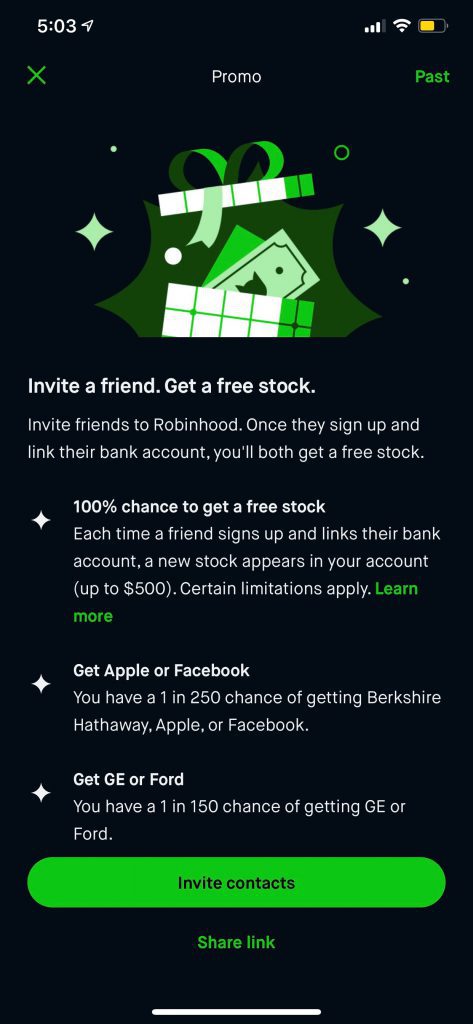
Word of mouth is the most powerful influence your online store can have going for it.
In fact, a study by Nielsen reported that 92% of consumers believe suggestions from friends and family more than advertising.
Now, if you’re looking for tools that help your direct response campaigns get referrals, check out ReferralCandy. It’s a referral generating platform that gets your customers to tell their connections about your product and service. And it does so by incentivizing customers to make product suggestions on your company’s behalf.
For example, when a customer buys something from your e-commerce store, they automatically get a referral code that they can easily share with their friends and family. And when a friend of theirs makes a purchase with that referral code, two things happen:
- The friend gets a discount on their purchase, and
- The referrer earns rewards from your online store.
You can choose to reward the customers that refer your business with either coupons or cash.
#3. Direct response marketing example: Run an online contest
Giveaways and contests are one of the best ways to quickly increase engagement on Facebook. And the best way to run a Facebook contest is via Messenger.
Running a Facebook giveaway with a Messenger bot is an effective tactic for generating new leads, getting more fans, and expanding your network reach.
But contests using a chatbot to do the heavy lifting have even more upside:
- Instant lead and data capture
- Low-friction for user participation
- Automated follow-ups and management

Furthermore, running a Facebook contest is an opportunity for lots of innovative ideas. And that’s because you can get creative with the rewards, prizes, and incentives you decide to offer.
Keep in mind that it’s important to focus on aligning rewards with your brand and the giveaway you’re running. Giving away an Amazon gift card only provides an incentive to get a gift card, which has nothing to do with your brand.
Instead, the prizes you giveaway should be things that your target audience would like to receive.
Check out these 10 Facebook Messenger bot contest examples for more ideas!
#4. Direct response marketing example: Drip marketing campaigns
One reason tracking customer behavior is so important in direct response marketing is because it may take a few actions before the customer is ready to buy.
That’s why you don’t need to focus all your time and attention on the bottom of your funnel.
While the direct response is about driving a specific action with a single CTA, that action can change from one phase of a campaign to the next.
Instead, you can make your chat visitor aware of some of your non-sales content as well. Think of it like having a casual conversation with someone about your business, without pushing sales at all.
Be aware of many marketing automation tools include drip campaign features for Facebook, web chat, SMS, and other popular platforms.
The drip campaign feature allows you to set up a sequence of messages delivered at specified intervals.
Marketers rely on drip campaigns to:
- Welcome and onboard customers
- Keep leads engaged with the brand
- Activate the use of sophisticated solutions
- Leverage automation to communicate at scale

Drip campaigns for email aren’t new. But chatbots bring drip campaigns to the next level with higher open rates and engagement rates.
Creating a drip campaign is something you only need to set up once. And drips are a powerful tool to keep customers engaged as you continue to send them valuable, relevant content.
#5. Direct response marketing example: Offer up the free stuff
Free offers are by far one of the best direct response marketing campaigns to run. For example, what if there was a free tool you could use to fully automate lead capture on Facebook?
Well, here’s a real-life example of that free offer!
Use messenger to ask for email addresses from Facebook. And this free offer is great because, with just a few clicks, you can turn your Facebook fans into leads. These are people who follow and like your company’s page on Facebook.
And you capture their names, emails, and phone numbers – automatically!

Here’s how the free Facebook Lead Generator works:
- Fans and prospects message your Facebook Page and comment on Posts.
- Create auto-replies in Messenger to collect emails and phone numbers.
- Check your email report containing all your new leads.
- Use messenger to re-engage your leads at any time.
So, don’t let hot leads on Facebook fall through the cracks.
Add a free, automated answering service to your Facebook Page and Posts to capture critical contact info so you can follow-up with prospects fast using a Free Facebook Lead Generator.
#6. Direct response marketing example: Text message marketing
Text marketing is an increasingly popular marketing strategy. The channel sees an average open rate of 98% and is one of the cheapest, easiest ways to reach anyone, anywhere, at any time.
Here a few SMS marketing statistics that tend to surprise many digital marketers:
- Text messages have a 98% open rate.
- Marketers see 6-8X the engagement when comparing SMS vs email.
- Response rates of 45% and an average response time of 90 seconds.
Reaching out proactively and engaging with segments of your audience is effective in moving prospects to the bottom of your sales funnel. And one of the most powerful proactive channels is text message marketing.
For example, after opting-in new SMS subscribers with an SMS Keyword, you can send bulk text messages to that audience with announcements, news, and deals.

Check out these 10 super effective SMS marketing tips and best practices for more ideas!
#7. Direct response marketing example: Upselling strategies
According to GrooveHQ, The probability of a new prospect buying is about 5-20%, but the probability of successfully selling again to an existing customer jumps to 70-90%.
And you can upsell products online using chatbots. Whether it’s a Facebook Messenger bot, an SMS bot, or a live chatbot on your website, you’re creating new contacts with every lead and customer who starts a conversation.
Next, it’s time to let your subscribers know about products and offers, sales, and promos.
Here we’re going to build a popular and effective chatbot use example: a sale or promo bot blast.
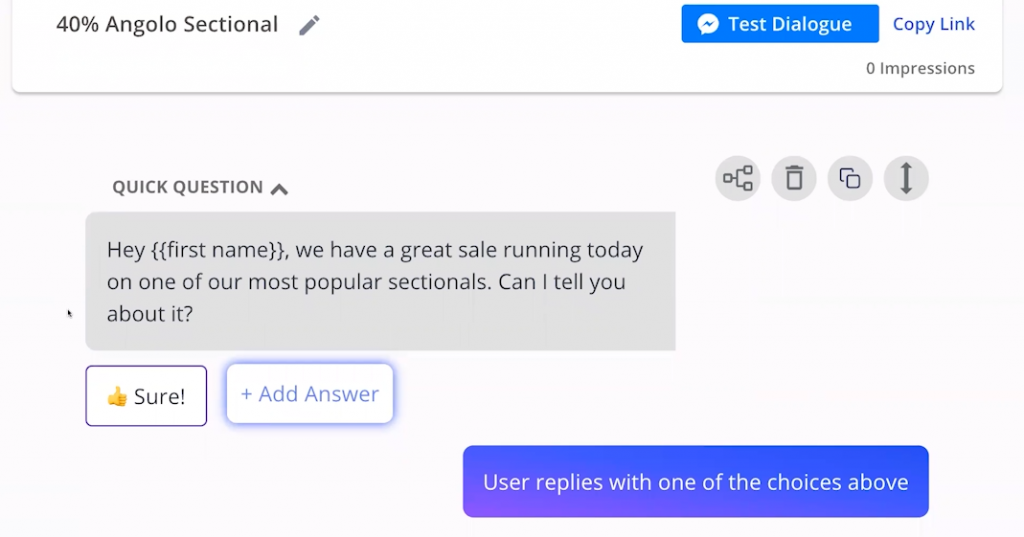
In the screenshot, notice how scarcity is used by emphasizing that the sale is running today. People want more of what they think they can’t have for much longer!
Notice also how subtle social proof has been added with ‘one of our most popular sectionals.’
Finally, at the end of the message, a question has been asked, which triggers the impulse to reply with an answer that we mentioned before.
In one tiny chatbot message, we have used three powerful psychological triggers!
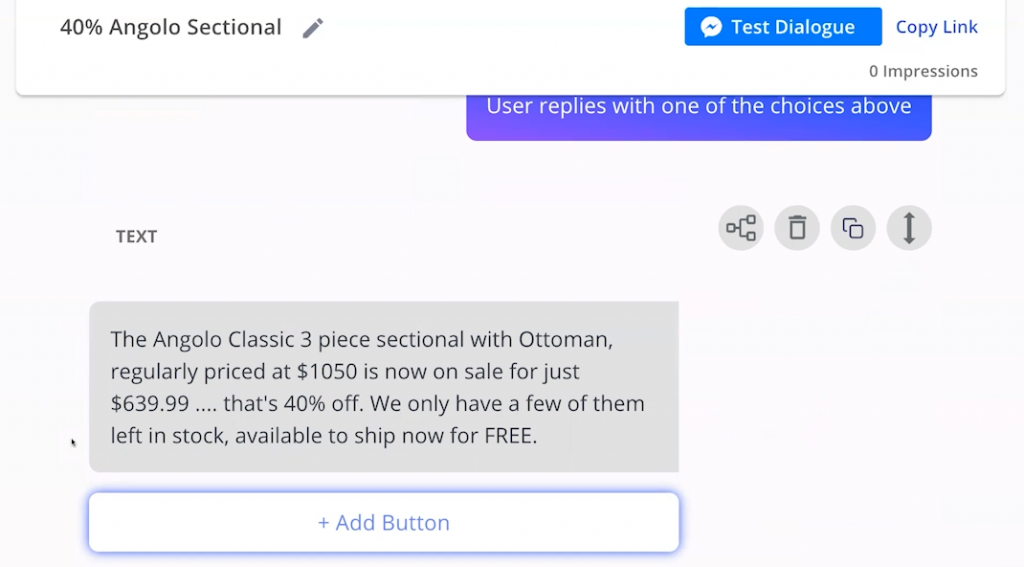
This creates a sense of urgency without having to give away any discounts or freebies. Urgency can be key in a direct response campaign because it encourages action now.
Benefits of Direct Response Marketing
There are many benefits to direct response marketing. Here are just a few of them:
Create a direct line of communication with prospects
In contrast to brand advertising, which uses more broad targeting to build brand awareness, direct response advertising is highly personalized, conveying specific information about how the product or service can help the prospect.
This level of personalization enables prospects to feel more comfortable and connected to the brand and the offer, inviting them to communicate with the company openly.
Provide a great ROI (return on investment)
Although brand advertising can be extremely effective, it’s also costly and time-consuming to pull off successfully. While this isn’t an issue for major brands with limitless advertising budgets, it’s not as easy for smaller businesses with fewer means.
The few times they run their brand ad is nowhere near enough to compete with those other large brands, and the result is being drowned out and producing little to no ROI.
On the other hand, direct response marketing can be useful regardless of your budget. As long as you’re paying for clicks, you stand an equal chance of generating a high ROI.
Produce easily trackable and measurable results
By tracking how many conversions you’ve generated from each direct response campaign, and where those conversions originated, you can measure the overall success of each ad.
Then, optimize or remove those campaigns that aren’t producing a positive ROI.
Build and strengthen relationships with customers
Communication isn’t just used at the start of the buyer’s journey. Use direct response marketing throughout the entire customer journey in order to improve the purchasing experience, such as upsells, drip campaigns, free offers, and more.
This article help give ideas to strengthen your relationships online and give you more ideas to help direct you to measure your results. Keep increasing your skills with each test you apply.
Important Next Actions
- Create a free chatbot today with Alecia Stringer, Contact her to learn how to get set up with your first 250 subscribers.
- Talk and learn about live video strategies with Alecia inside her Facebook group Let’s Go Live Mastermind.
- Advance your marketing performance with personal marketing strategies with Funnel Training HERE.

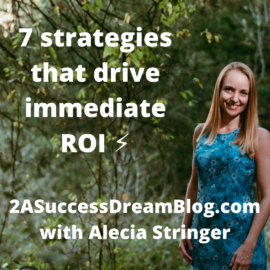


Leave a Reply